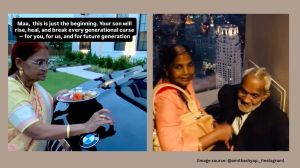Home Alone
With elections scheduled in Gujarat later this year, the opposition to Modi appears to be growing stronger. And it’s not the Congress

The BJP recently suspended five rebels out of the six who voted for the UPA candidate in the presidential poll. The party bosses in Delhi know that disciplinary action is not the solution to the problem. More than one-third of the BJP MLAs in the state have been known to wage war against Narendra Modi’s leadership through the last five years. The suspensions will have a far reaching impact on the future of the party as it prepares for the assembly polls later this year.
Modi became chief minister in October 2001, ousting Keshubhai Patel, a seasoned swayamsevak and organisation man. Patel was not a strong CM. He received a setback when the party lost the local government elections in 2000. Yet party stalwarts, including Keshubhai’s critics, did not welcome Modi as an alternative. Modi had no base in the party or a social or regional constituency to call his own. After becoming CM, he won his own election with a very thin margin from Rajkot in February 2002, although the constituency was considered safe for the party for over a decade.
The 2002 carnage changed this scenario. All BJP factions and the Sangh Parivar rallied together to fight the subsequent assembly polls under the Hindutva battle cry. It was an emotive issue that suited the Parivar’s political instincts. There was an imperative to recover from the defeat of the panchayat polls. The fear psychosis that was sought to be built and stoked during the campaign, alongwith the catchy question “apanu kon”, inflamed passions.
But the tempo could not be sustained for long. The power struggle has its own logic. With the massive victory he won after the riots, Modi’s image grew larger than life. His confidence in himself as the best campaigner, master manoeuvrer and administrator was boosted. Thanks to the compulsions of democratic politics and the larger political forces, he appears to have given up the visible signs of the RSS and VHP brand of Hindutva of late. But there is enough evidence to show that the mindset of the pracharak is unchanged. As is the authoritarian streak he has displayed throughout his tenure as chief minister. In his five years in power, he has destroyed the party structure and circumvented its functioning. He has alienated the Sangh Parivar as well as the party rank and file.
The dissidents are up in arms against Modi for basically three reasons. One, they are irked by and tired of Modi’s “autocratic and self-centred style of functioning”. They feel that they are sidetracked in all major decisions; the CM does not grant them even a hearing. Their demands and complaints are not attended to by the administration; their ego has been repeatedly, sometimes publicly, hurt by Narendrabhai.
Two, the average grassroots party netas who have been in the BJP for more than three decades do not get to share in the spoils of power. They do not get the goodies that naturally flow to party workers in a democratic system. Three, with time they see that the party is losing popularity in a cross-section of society, as the tangible benefits of the so-called vibrant high growth economy have not percolated to the aam aadmi. They fear that Modi could re-enact the post-Godhra carnage, but they also know that it is not possible without the support of the Parivar.
But the major challenge that Modi faces in the run-up to the polls is from the Koli and Patidar dissidents. Kolis, a major OBC group, constituting nearly 24 per cent of the population, are by and large small and marginal farmers and landless labourers. They have traditionally been Congress voters as they perceived it to be a party for the poor. However, their preference vacillated between Congress and BJP in the 1990s.
The majority of the Kolis voted for the BJP in the 1995-96 polls, thanks to their mobilisation by Shankarsinh Vaghela. They shifted to the Congress when Vaghela joined the Congress. However in the post-carnage 2002 elections, they voted for the BJP. But within no time, in the 2004 Lok Sabha elections 55 per cent of the Koli vote went back to the Congress. This pro-Congress trend is likely to speed up in the coming months.
The Patidars, nearly 13 per cent of the electorate, dominate rural Gujarat. They have been anti-Congress since the mid-1970s with the ouster of Chimanbhai Patel from the Congress. They have been strong supporters of the BJP since the early 1990s. For the first time recently, sections of this community have changed their party preference. According to the CSDS survey, BJP Patidar voter declined from 79 per cent in the 2002 assembly polls to 67 per cent in the 2004 Lok Sabha elections. With the ouster of Keshubhai as chief minister, a section of the community nurses a hurt. The suspension of five Patidar leaders from the party recently has added fuel to the fire. On the other hand, their antagonism vis a vis the Congress has been weakened as land reform is no longer on the Congress agenda. Moreover, they are unhappy with the Modi government’s policy on agriculture.
It is still too early to foretell the impact of these trends on the outcome in the elections later this year. But they will certainly erode the party’s traditional social base and deepen the anti-Modi and anti-BJP mood that seems to be in the making.
The writer is a former professor of social science, JNU





- 01
- 02
- 03
- 04
- 05


























